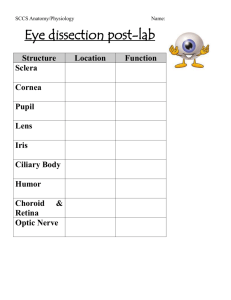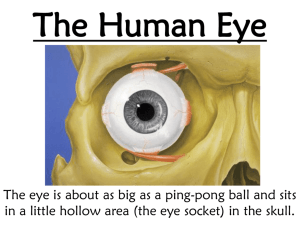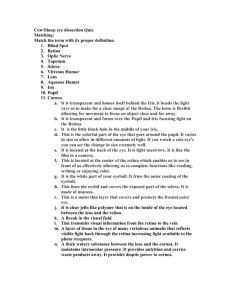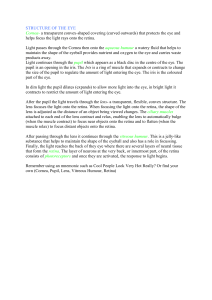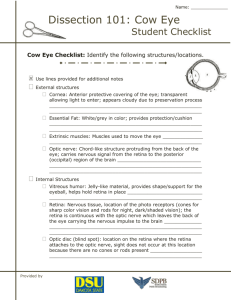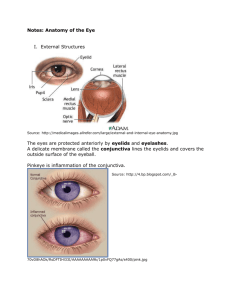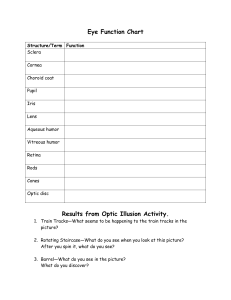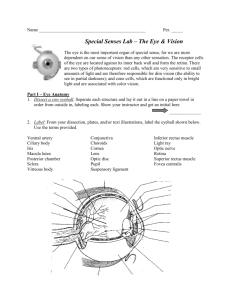The Eye Structure - Macro and Microscopic
advertisement
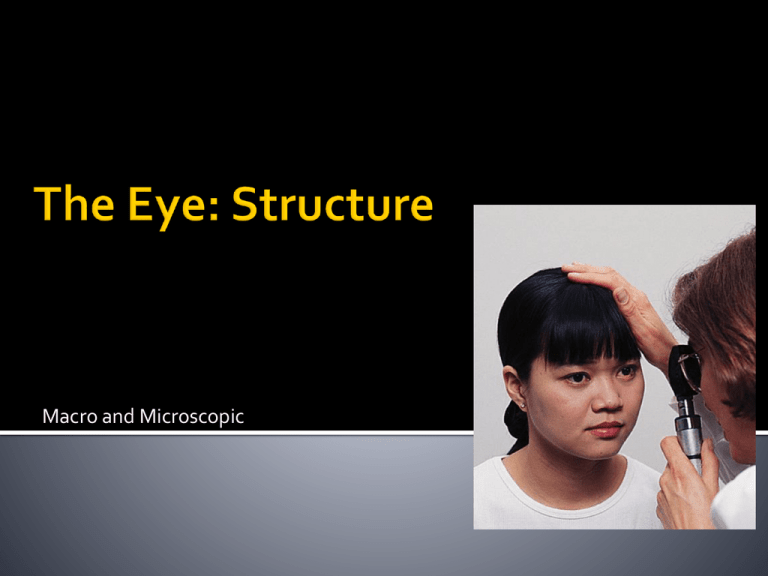
Macro and Microscopic Protected by bony orbits of the skull Send information to brain directly via optic nerve. From 2 outgrowths of the brain that form the optic nerves & the optic cup: The posterior lining of the eye contains photoreceptors In a mature eye called the retina Palpebrae: eyelids! Thin flaps of skin Controlled by orbicular muscles Close when objects are placed near the eye: reflex arc Eyelashes Edges of eyelid Protect from dirt 1. Iris 2. Lacrimal caruncle 5. Lower lid 7. Pupil 8. Sclera 9. Upper lid Sclera Choroid Retina Tough, outermost, white layer Surrounds and protects the eyeball. Its front surface, the cornea, is transparent to let light enter the eye. Lacks blood vessels Gets nutrition through diffusion Ideal for transplants The choroid coat is the middle layer of the eyeball. Consists of the colored portion of the eye known as the iris. Iris has a hole in its center called the pupil. Light enters through the pupil and the size of the pupil is regulated by the iris. Constricting = parasympathetic muscles Dilating = Sympathetic muscles Too much light “bleaches” the photopigment, rhodopsin to opsin Reduces ability to see Opsin must be “reconverted” to rhodopsin This is related to “night vision” issues with sudden darkness… Transparent body Lies directly behind the pupil Held in place by ciliary muscles (run in circular, longitudinal, radial orientation; change lens shape) Focuses light rays of images on the retina Images inverted (both L to R and Up to Down) Visual cortex reorients these Increases amount of energy reaching photoreceptive cells What happens when source moves closer? All light isn’t focused on retina Makes image “fuzzy” because adjacent cells stimulated An “accommodating” lens clears image up by refocusing light Close image = ROUND lens (decreases radius of curvature) Far image = FLAT lens (increases radius of curvature) To round the lens, contract muscles in ciliary body: Contracting a circular muscle reduces the aperture This decreases the tension on the suspensory ligaments, allowing lens to “round up” Innermost layer of the eyeball. Contains microscopic structures: Rods ▪ Low-light ▪ Non-color vision Cones ▪ Bright-light ▪ Color vision At center of retina, have fovea centralis Concentration of cone cells 1:1 cell/neuron ratio (gives good resolution) Farther outward, mix of rods and cones, with just rods in peripheral vision Mostly b & w, low-light, low-resolution peripheral vision Eye directs fovea centralis at objects to maximize clarity A “blind spot” occurs where the optic nerve/tract exits the eye Optimal vision Blind spot Aqueous humor—in the anterior cavity in front of the lens Provides nutrients to cornea, lens, other structures Vitreous humor—in the posterior cavity behind the lens Gelatinous Holds retina to outer wall of choroid May contain “floaters”, which must be removed surgically Mucous membrane covering the front surface of the sclera and lining the eyelid Produces tears Barrier to microbes Susceptible to trauma, infections, chemical irritation, and allergic reactions Conjunctiva: thin, transparent epithelium covers the surface Tiny blood vessels Innermost layer of retina contains rods and cones Impulse travels from the rods and cones through the bipolar and ganglionic layers of retina Nerve impulse leaves the eye through the optic nerve; the point of exit is free of receptors and is therefore called a blind spot Visual interpretation occurs in the visual cortex of the cerebrum

